Baynun#
by Hasso Hohmann, 1992
It was the January 14, 1992. I woke up in Saana
Sanaa, Jemen
, captial of Yemen. It was later than usual for me, since the day before it had gotten quite late. I had breakfast only at 8 a.m. and hurried up.
First I went with an urban share taxi to the taxi stand for southbound overland. I managed to get into an - already at 9.00 am - almost full taxi. With twelve other passengers all the seats were taken and so we set off immediately. I just wanted to Dhamar
14.5440701,44.3866409,
which is about 80 km away in linear distance and where we arrived at about 11.30.
There on the main square, I asked the pausing 5 taxi drivers in sign language for the price of the trip to Baynun which was written in new Arab numbers. As I had already copied the villages from an American military map on the way and learned by heart, I also asked for these villages. It soon turned out that the price expectations laid around 800-2000 Yemen Real and actually only the cheapest actually knew the route. I even bargained him down to 600 Real; then we took off.
The driver looked frightening, but had a pleasant way. Nevertheless I was amused by the idea that my mother could see me here and how she would throw her hands up in horror. My driver was wearing a long white wraparound skirt. Also the rest of his clothes was white up to his turban. But despite the wrinkled face he was probably not more than 35 years old. He also gave a farmer with two goats and two heavy sacks a ride and sat him in the back of the four-wheel drive Toyota pickup. The farmer was an additional income. The two heavy bags were still were on the truck bed on the way. He explained that the vehicle would jump less at the many bumps.
I was sitting on the passenger seat. During the whole trip a Kalashnikov laid at hand - for safety reasons, as the driver indicated. In the beginning the road was in quite a good condition - it was the main road to Rada Rada and then to Al Bayda and once it must have been paved. After 30 km driving east we had to turn to the north. From there we had to continue on a bad dirt road. The road soon became even worse, then led temporarily on the bare rock on which no more tracks were visible. If the driver doesn’t know the direction exactly in these sections of the path, he hardly ever reaches his destination. Obviously, the road was used very seldom. On the entire route we met no other vehicle in both directions.
It took us two and a half hours to get from Dhamar to Beynun. The ride went through a highly rugged area with powerful volcanic deposits. For a long time on both sides of the valley halfway up the valley slopes about 30 meters high layers of mostly vertical basalt columns were to be seen.
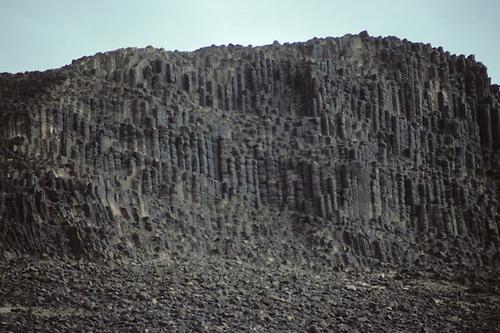
Photo: H. Hohmann, 1992, under CC BY-SA 4.0
At some narrowings of the road the profile of a former smaller dam was visible in the lateral erosion profile of the valley floor, which had obviously been raised after filling up the basin behind the dam with sediment. The first dam was carefully built, the second just earthwork, built on the sediment and shifted backwards. Later I saw another dam being ramped up. All these dams probably had the problem of rapid siltation.
If it rains in this dry area, it rains heavily and large amounts of water rush from the highlands into the valleys, they carry lots of bed load with them, which, when it is jammed behind a barrier and comes to rest, drops out and sediments at the bottom of the storage space and thus reduces the storage volume. Therefore, yet in Sabaic times and also during the time of the Himyaritic Kingdom the dams had to be ramped up. This was done all over the country until the structures were too high and too heavy and no longer could be stabilized.
Along the road there are also several small villages that were almost entirely destroyed by earthquakes or armed conflicts. An earthquake in December 1982 had caused alleged 3500 deaths just here, the driver signified. But also clan feuds contributed repeatedly to the destruction of buildings and entire villages. Nowadays, the conflicts in this area are staged with grenades, machine guns, knives and small cannons - man against man, house against house - an often practiced way of solving problems.
At the beginning of scattered settlement in the valley of Beynun our farmer with the two goats got out and paid. We drove a little further up to a slightly larger house. It belonged to the mayor of the villaged name An-Numara, whom my driver knew and we were asked to tea and lunch. Also his house - a rural estate - was damaged by earthquakes and constant gunfire and partly destroyed. Throughout the house were almost no intact window panes. The late lunch was taken upstairs and consisted of fresh pita bread and a very nutritious and delicious thick hot soup with beans, lentils and other ingredients. During the meal, somebody shot from above the village at the house of my host, so that another window pane of the dining room was splintered, but nobody seemed to bother - dinner was not interrupted. Only the guest from distant Europe seemed to be made nervous.
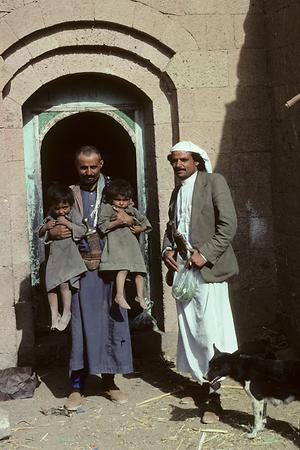
Photo: H. Hohmann,1992, under CC BY-SA 4.0
After the meal, the taxi driver took me on a steep rocky road on the left side of the valley uphill to the ruins of ancient Baynun. We came by some houses with late antique spolia and reliefs. At the end of the slope I noticed especially a house with a beautiful high relief stone of white marble, which showed very naturalistically a bull in frontal view. Unfortunately, he was badly damaged on one side. He had a typical early Himyaritic design. When the steep narrow road levelled out, we turned sharply to the left around a spur of rock and reached a bottleneck before we entered into the upper village. Here we were confronted suddenly with a small private army from the upper village of about seven people with their weapons at the ready. They obviously had expected us and prevented us from journeying on. When even a long discussion between the leader of the small group and my driver led nowhere, we turned round and went back to the mayor of the lower village.
There, first it was discussed violently and loudly for a few minutes, confered, and then, at a whistle, from several houses seven young men with Kalashnikovs, curved daggers and guns came to the mayor to immediately jump onto the truck bed of the pickup. The two bags were taken temporarily off the truck bed and deposed with the mayor. Although I declined with thanks, we went back up the hill, now with "military back-up". Given the high weight on the truck bed and the slope of the road, the Toyota had to struggle up in first gear. Arrived at top negotiations were opened again on the basis of the same "military strength" in the middle of the upper village. At first, the two opposing sides were eyeball to eyeball with their weapons levelled at each other. Later on, "my" young fighters climbed from the car and sat down to a discussion on a brick bench. As a result, after about a quarter of an hour I was allowed to go to the ruins, but had to leave my camera in the car. So they had found a compromise in which neither side lost face. Fortunately, diplomacy had triumphed with a military threatening gesture. Perhaps it is interesting to mention in this context that there is a quite unique discussion technique in Yemen for often almost hopelessly seeming disputes: The opponents have to put forward their arguments in verse. But this kind of negotiation was obviously not necessary in this case.
Just about the level of the upper village on the here flatter slope the road to the ruins led around a side valley. The ruins soon began and formed a horseshoe-shaped zone around the valley. I went to the ruins within earshot to the upper village. The ruins stretched across large parts of the mountain slope above and below the main path and covered a very widespread area. There are reports that Baynun was temporarily also the capital of the Himyaritic Empire until around 525 AC it was conquered and destroyed by the Axumites from Ethiopia. However, the stones are mixed up so evenly that I had the impression that this cannot have been only the work of hostilities and destruction. There are almost no traces of visible upstanding walls. Also from the royal palace in Baynun nothing recognizable stood out from the rubble. Therefore I think that after their capture the remains of the city additionally were brought into this state by at least one very big earthquake. After about an hour of visiting the ruins, in which apparently archaeologists never had dug before, the driver made me understand by whistling, shouting and waving that I should come back. This was very understandable, as besides him also my small private army was still waiting for me.
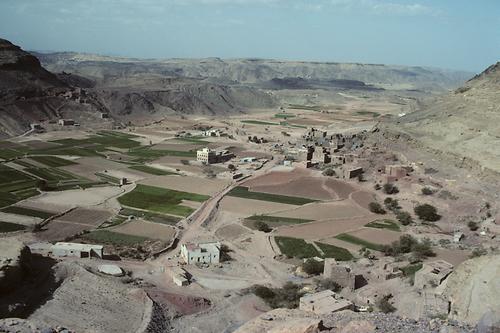
Photo: H. Hohmann, 1992, under CC BY-SA 4.0
I copied a small block of stone with a short inscription consisting of only 4 characters, which had been immured upside down provided as a spoila into a contemporary arche, into my palm. I transferred the drawing later into my notebook. The inscription could be carved into the stone in the 1st to 4th century A.D. This seems to be indicated by the shape of the letter for "w", which in early writings usually appears as a circle, vertically divided by a stitch, but over time changed to two smaller and adjoining, only tangential circles or ovals. The variant of the letter used herein looks like the early stages of such a "division" and may well be even called early Himyaritic or late Sabaean. I also made a sketch-map from memory later on. The ruins are very extensive and are apparently the remains of a relatively large ancient city.
The reason for my problems visiting the ruins of Baynun was probably that I was invited by the Mayor of the lower village and this was obviously observed from above - and the two villages live in constant dispute. As I stood quasi under the protection of the lower village, the people there felt obligated to help me with my intention to visit the ruins.
After returning with "my" small force to the lower village we moved straight on to my main goal in Baynun, the ancient tunnel which once in Himyaritic times had to divert the water from a water-rich parallel valley in the east under a ridge to the fertile valley of Baynun. Carved inscriptions at the entrance to the tunnel portal centrally arranged and one on both sides atop under the ceiling of the tunnel inform about planning, age and function.
First, some of my companions came with me together with the mayor and the driver. Afterwards, the group became smaller. In the tunnel, there were only the driver and two young boys left. After also the driver joined the mayor, I had only two companions. At the outlet the bottom of the tunnel lies significantly higher (about 8m) than the valley floor of Baynun. Therefore, it must have been connected to an aqueduct system, through which the water was distributed to the fields in Baynun Valley but, however, nothing is left of it. The lower as well as the upper part of the channel lead in an open incision through the mountain. The width of the channel is around 4 meters along the entire length of the stitch. The depth of the incision extends to estimated 25 m on both sides. The tunnel itself has a length of approx. 100 m and, heightwise, about 4m at the inlet and about 6 m at the outlet. Pretty much in the middle of the tunnel you can find an S-curve which measures just over 4 m and is obviously explained by the fact that the tunnel was driven into the rock on both sides at the same time and the survey on the outside, across the mountains, 2,000 years ago was not quite as accurate as with today's geodesic precision instruments. Summing up incisions and tunnels, the total length of the channel through the ridge is about 170 m.

Photo: H. Hohmann, 1992, under CC BY-SA 4.0

Photo: H. Hohmann, 1992, under CC BY-SA 4.0
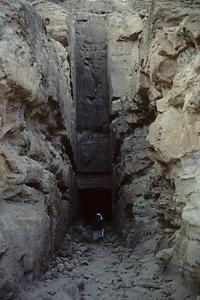
Photo: H. Hohmann, 1992, under CC BY-SA 4.0
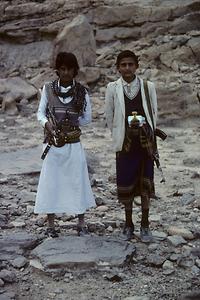
Photo: H. Hohmann,1992, under CC BY-SA 4.0
Also on the inlet side the valley floor is significantly lower than the channel. Here, after a deviation of the channel of approximately 90°, it follows the slope in a channel running parallel to the mountain. For this purpose, the channel has been chiselled from the rocky slope in its full width of 4 m and a corresponding depth of 4 to 7 m. Further up it ends in the remains of a once great impoundment. One can see clearly the sedimentations and, up the valley, on the secondary erosion slopes, the remains of the ancient wide dam. After the bursting of the dam and later rains this was almost completely ablated and the horizontal sediments behind it largely washed out again. The impoundment behind this dam served as the water reservoir which charged the canal into the valley of Baynun.

Foto: H. Hohmann, under CC BY-SA 4.0
It had become quite late. So we could just drink a cup of tea and soon had to say goodbye to the mayor, his good friends and to Baynun and its inhabitants, then we went back through the valleys in a nice evening light. When it got dark, the track was hard to find. Just before Dhamar the driver brought me to a place where share taxis, also those from Taiz, meet. Here the vehicles turn from the main road Taiz - Sanaa to Rada. I got off the taxi about 20.00 h in complete darkness, paid my driver the agreed money and we parted amicably.
After about half an hour a share taxi on its way to Sanaa arrived, stopped and gave me a lift, although actually there was no more space left in the car. They moved closer together. The driver drove well and rather fast - usually at 120 km/h, which is quite fast on a narrow mountain road, even if it is one of the main roads in Yemen. Some passengers complained which was no good. On a very winding road section just before a summit we were turning around a spur in a non-visible narrow right turn, when we were eyeball to eyeball in about 40m distance with two overtaking, dimly lit trucks taking in the entire road width and driving towards us. I actually saw no solution to the problem. Everything took place as if in a slow-motion movie. you could not see much because it was black night outside. Our quick-responsive driver drove as close as possible to the right, vertically ascending rock. For a split second, metal shrieked - on stone to the right and on the body panel of the overtaking truck to the left. The noise was incredible, the whole car was chocked off, yet shaken. The passengers screamed. Immediately afterwards, we pulled out of the narrow ditch beside the wall of rock onto the road and had not gone head over heels. It was almost a miracle that we were still alive and the car even could move. I do not know if one of the trucks fell over the road edge into the abyss, but I could imagine! In Yemen, one does not check such things. Too often innocents became the guilty ones. All my fellow passengers in the car called on Allah in prayers of thanks. Some also complained about the fact that the driver had been driving too fast. But instinctively, the driver had reacted optimally in this situation. His car was badly damaged by the irresponsible overtaking of the truck. He drove on for a short distance, then he stopped and inspected the damage with an flashlight already brought along. One of the doors could no longer be openend and all the doors and the splashboards were badly damaged, the outer panel was downright torn down or rolled up from its frame partly. But all the four wheels and tires were still functional. From then on, the driver continued the trip to Sanaa with a maximum speed of only 80 km/hr. Also the continuation of the journey was accompanied by intense prayers of the other passengers: Allah is great!
Also consult the essay in the excellent book on Yemen: